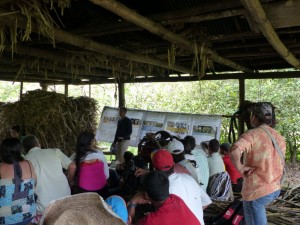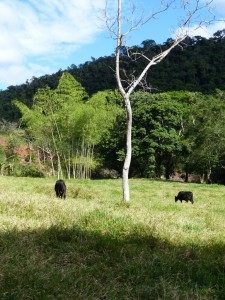Last week (19-22 May), we attended a workshop on participatory agroforestry organized by our partner Instituto amazónico de investigaciones científicas Sinchi in Caquetá, Colombia. Five different agroforestry systems are being proposed to communities in San José del Fragua and Belén de los Andaquíes, as follows:
Option 1: Cacao, Timber trees.
Option 2: Cacao, Native timber trees.
Option 3: Native timber trees in secondary growth.
Option 4: Rubber, timber and fruit trees.
Option 5: Fruit and native timber trees.

Project study area in Colombia
All systems will include plantain to provide shade during the establishment phase, and as a cash crop while the fruit trees, rubber and cacao are ready to generate income for the farmer. Each farmer will have the chance of implementing three different agroforestry system in their farms, by reserving one hectare for each system.
Such systems were designed by our partner Sinchi based on scientific evidence, and after assessing the expectations and willingness of farmers to include these arrangements of species.
As a result of this workshop, the overall trend in these communities is a remarkable preference on timber trees, rubber and cacao, due to current high prices (2 USD/kg) and a well-developed market in the region. Systems with native fruit trees such as copoazu (Theobroma grandiflorum) are not widely preferred because the market of these fruits is not well developed yet, so people are hesitant to implement these systems in their farms. This could change in the future when communities start organizing themselves and produce critical volumes attractive to willing buyers.
The workshop was very active and lively with discussions between participants, and in the end participants chose the system with which they felt most comfortable.

Participatory workshop led by our partner Sinchi
The last couple of days in the region (22-23), we attended a different workshop, this time organized by our partner CIPAV (Fundación Centro para la Investigación en Sistemas Sostenibles de Producción Agropecuaria). The focus of this workshop was silvopastoral systems. We observed several alternatives that CIPAV is already working with in the region, like intensive silvopastoral systems, scattered trees within a field (considering plant succession) and (mixed) forages banks. In addition, we started looking at the costs of each system designed by CIPAV. In the coming weeks, CIPAV will organize a participatory workshop with farmers to define the silvopastoral systems that will be implemented in their farms.
This visit will enable us to understand better and track the costs associated to the implementation of these agroforestry and silvopastoral systems, identify hidden costs (if there are), and some of the incentives that farmers find for implementing such systems in their farms.

Cows in typical Caquetá landscape
Written by: Paul Peters and Paula Caicedo. P. Peters and P. Caicedo are part of the project Sustainable Amazonian Landscapes, a project led by CIAT and implemented together with the Potsdam Institute for Climate Impact Research, CIPAV, Instituto Amazónico de Investigaciones Científicas Sinchi, Universidad de la Amazonía, IIAP, and Universidad Nacional Agraria La Molina. This initiative is funded by the International Climate Initiative (IKI)






